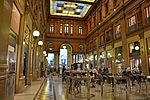Santi Bartolomeo ed Alessandro dei Bergamaschi

Santi Bartolomeo ed Alessandro dei Bergamaschi (Saints Bartholomew the Apostle and Alexander of Bergamo of the people of Bergamo) is a little church in Piazza Colonna in Rome, Italy, next to Palazzo Wedekind. Originally it was named Santa Maria della Pietà, from the high relief over the door. The present Santa Maria della Pietà in Rome is in Vatican City. In its origins (1591) the church was the chapel erected by padre Ferrante Ruiz for the Ospedale dei Pazzarelli, Rome's first insane asylum. When this was moved to Via della Lungara in the 1720s, the church was given over to the Archiconfraternità dei Bergamaschi, who rebuilt it in 1731–35 to designs of Giuseppe Valvassori, added their patron saint to its dedication and used the hospital for their own sick. It is the burial place of Cardinal Giuseppe Alessandro Furietti, antiquarian and native of Bergamo. It is looked after by the Arciconfraternità, a historic association of Bergamaschi living in Rome that was begun in 1539. It supports understanding of the culture, the values and the traditions of Bergamo and their fertile dialogue with those of Rome.
Excerpt from the Wikipedia article Santi Bartolomeo ed Alessandro dei Bergamaschi (License: CC BY-SA 3.0, Authors, Images).Santi Bartolomeo ed Alessandro dei Bergamaschi
Piazza Colonna, Rome Municipio Roma I
Geographical coordinates (GPS) Address Nearby Places Show on map
Geographical coordinates (GPS)
| Latitude | Longitude |
|---|---|
| N 41.900555555556 ° | E 12.48 ° |
Address
Roma Store
Piazza Colonna
00186 Rome, Municipio Roma I
Lazio, Italy
Open on Google Maps










